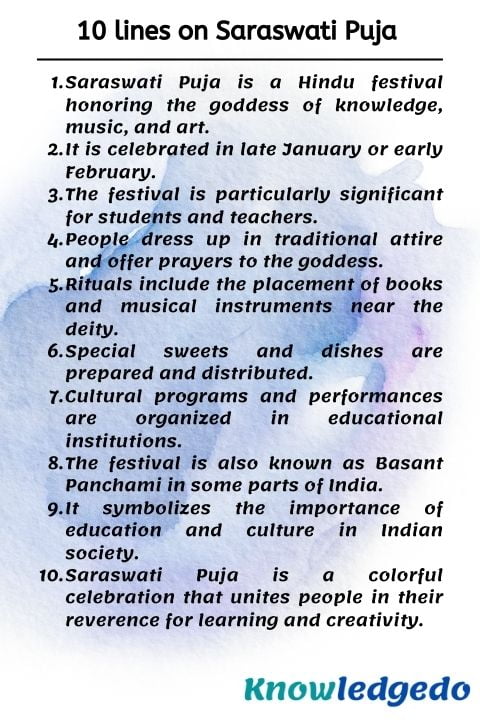Today, we are sharing 10 lines on Saraswati Puja in English. This article can help students who are looking for information about 10 lines on Saraswati Puja. This essay is very simple and easy to remember. The level of this essay is moderate so any student can write on this topic.
This article is generally useful for class 1,class 2,class 3,class 4,class 5,class 6,class 7,class 8,class 9,class 10,class 11,class 12
10 lines on saraswati puja
1) Saraswati Puja is a Hindu festival celebrated to honour the goddess of knowledge, music, and art, Saraswati.
2) It is usually observed in late January or early February, coinciding with the onset of the spring season.
3) The festival is particularly significant for students and teachers, who seek blessings from the goddess for academic success and learning.
4) Saraswati Puja is celebrated in homes, schools, and colleges across India and other countries with Hindu populations.
5) On the day of the festival, people dress up in traditional attire, offer prayers to the goddess, and perform rituals like the placement of books and musical instruments near the deity.
6) The festival is also marked by the preparation and distribution of special sweets and dishes, including khichdi, lunch, and payesh.
7) Many cultural programs, music, and dance performances are organized to celebrate the day, especially in educational institutions.
8) In some parts of India, the festival is also known as Basant Panchami, which marks the arrival of spring and the blooming of flowers.
9) The festival is a symbol of the importance of knowledge, education, and culture in Indian society.
10) Overall, Saraswati Puja is a vibrant and colourful celebration that unites people in their reverence for learning and creativity.

10 lines on saraswati puja
1) Saraswati Puja is a Hindu festival honouring the goddess of knowledge, music, and art.
2) It is celebrated in late January or early February.
3) The festival is particularly significant for students and teachers.
4) People dress up in traditional attire and offer prayers to the goddess.
5) Rituals include the placement of books and musical instruments near the deity.
6) Special sweets and dishes are prepared and distributed.
7) Cultural programs and performances are organized in educational institutions.
8) The festival is also known as Basant Panchami in some parts of India.
9) It symbolizes the importance of education and culture in Indian society.
10) Saraswati Puja is a colourful celebration that unites people in their reverence for learning and creativity.
5 lines on saraswati puja
1) Saraswati Puja is a festival celebrated in honour of the goddess of knowledge, music, and art, Saraswati.
2) It is celebrated mainly by students and teachers seeking blessings for academic success and learning.
3) The festival is marked by the offering of prayers, special foods, and the placement of books and musical instruments near the deity.
4) Cultural programs and performances are organized in educational institutions to celebrate the day.
5) Saraswati Puja is a vibrant celebration that highlights the importance of education and culture in Indian society.
FAQ
Answer: Saraswati Puja is significant for students and teachers as it seeks blessings from the goddess of knowledge, music, and art, Saraswati, for academic success and learning. It also highlights the importance of education and culture in Indian society.
Answer: The rituals associated with Saraswati Puja include the offering of prayers to the deity, the placement of books and musical instruments near the deity, and the preparation and distribution of special foods. Cultural programs and performances are also organized to celebrate the day.
Answer: Saraswati Puja is celebrated in late January or early February, usually coinciding with the onset of the spring season. The festival is observed in India and other countries with Hindu populations.
